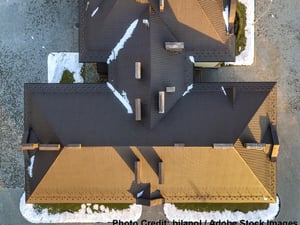One of the best things about a metal roof is that you usually won’t need metal roofing repair more than once or twice throughout the entire lifetime of your roof.
Shingle roofs need to be monitored closely for subtle signs of damage, including cracking and peeling. These symptoms can develop unexpectedly into serious problems.
Metal roofs, on the other hand, are designed to be highly resistant to the pressures that can cause problems for shingle roofs. In particular, they stand up to powerful wind, rain, snow, and hail. This makes them terrific for Austin area homeowners.
Metal roofs should be inspected at least once every two years and after major weather events. This is when you’re most likely to learn that you need metal roofing repair.
Six Metal Roof Problems And How An Expert Can Fix Them
Metal roofing repair should only ever be performed by an experienced expert because the needs of metal roof systems are different from those of shingle roofs. A roofer who lacks knowledge about metal roofing can actually cause more damage. 
Let’s look at six issues you might encounter in the lifetime of a metal roof:
1. Roof Overlay “Baking”
Baking is an issue when a metal roof system has been installed over an existing roof. This was once very common. If done incorrectly, moisture can get trapped over time and cause damage to the roof interior, which causes it to degrade rapidly.
2. Improper Offset
Metal panels can suffer from seepage if the offset does not permit complete coverage of the roof. A standing seam metal roofing system protects against seepage. For best results, panels should be fabricated on-site based on your precise roof measurements.
3. Short Fasteners
Fasteners are the structural weak point in any metal roofing installation. A standing seam system protects and reinforces them, ensuring they are not exposed to the elements. In “short fastening", an insufficient number of screws is used, leaving the roof vulnerable to wind damage.
4. Angled Fasteners
Fasteners must be perpendicular to the roof surface for maximum support. If fastener heads are not driven straight in, they can lift over time and promote seepage. A professional should verify that the right type of fastener has been used, then re-anchor them as soon as possible.
5. High Fasteners
Virtually all metal is subject to some degree of expansion and contraction as air temperatures change. Gradually, the pressure this produces can cause certain types of fasteners to lift upward. Any fasteners with rust damage should be replaced and all of them screwed flush with the roof.
6. Common Flashing Problems
Flashing is most visible around vent pipes and chimneys. It’s a relative weak point on even the strongest roofs, whether metal or shingle. With that in mind, it should always be monitored for rusting and “popping up.”
Longhorn Roofing helped bring metal roofing to the Austin area. Our team has installed hundreds of high-quality roofs right the first time. For metal roofing repair you can trust, contact us.


